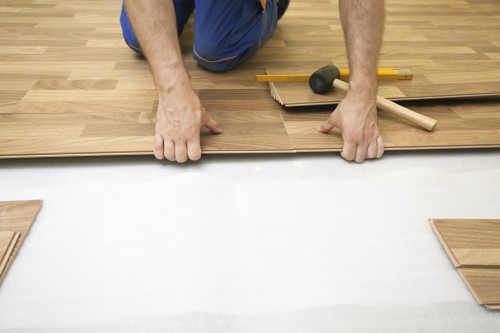
The success of your flooring installation will be determined by the techniques you employ when installing your sub-flooring. During sub-flooring panel installation, its best to apply an appropriate adhesive and to secure the panels with fasteners or floor screws to prevent squeaks and uneven flooring. Sub-flooring adhesives must be strong enough to maintain their bond over time, and elastic enough to allow for some movement in the sub-floor panels through pressure or when underlying joists shrink.
What causes squeaky floors?
Squeaks often occur as a result of changes in moisture content levels in the lumber used for joists in your flooring assembly. The squeaking you hear is the sound of the smooth shank of the nail rubbing against the OSB or plywood sub-floor panel. It’s best to use kiln-dried joist lumber or I-joists, but if you don’t have the time or money, or if the wood is wet, it’s imperative that you utilize an adhesive when installing the sub-floor panels. In fact, it’s always advisable to use adhesives and the proper fasteners when repairing or building new floors to mitigate the possibility of squeaks down the line.
Squeaks can also be caused by the improper application of the adhesive between the joists and sub-floor panels or by using the wrong adhesive for the job. Here, the OSB or plywood sub-floor panels can lift away from the joists and cause the nails to loosen. Squeaks can also be caused when there is movement in the floor and joists or panels rub against heat ducts or metal joist hangers that have not been properly installed or fastened.
Correct application of adhesives
When an adhesive is applied in inclement weather (or on lumber that is wet, frozen or dirty) its performance may be compromised.
Only apply enough adhesive to install two or three panels at a time. Waiting too long between application of the adhesive and bonding may compromise the adhesive’s performance. Adhesives that are allowed to dry or skimmed over do not allow the panel to lay flat on the joist and that can cause an uneven floor.
Run a zigzag pattern of adhesive along the joist before lowering the sub-flooring panel onto the joists. Running a small bead of adhesive in the groove of the sub-floor panel will increase the strength and stiffness of T&G panels.
Prior to floor installation
Inspect your sub-flooring carefully and ensure any problems are resolved before installing your finished flooring; sub-floors should be dry, clean and completely flat. Always follow your finished flooring manufacturer’s installation instructions.
Inspect the sub-floor fasteners to ensure that the paneling is adequately secured to the joists. If you find fasteners that are driven too deep, install additional fasteners. If you find fasteners sticking up above the panel surface, take the time to ensure they are flush with the surface of the sub-floor panels. Inspect from below for any shiners (fasteners that have missed joists) and replace them.
When using sub-floor adhesives, always completely fasten one sub-floor panel before starting on the next one. Failing to completely fasten each sub-floor panel as you progress may allow the adhesive to dry and that can lead to squeaks and other issues. Remember that the panel is only one component of the floor system and the entire system must be designed to work in harmony to ensure the perfect floor.
Always consult your local building codes for fastener spacing, size and type as there may be local requirements you must meet or refer to your design professional’s specifications. The APA construction guide E30V is a great installation document that is well worth reading. When done correctly, your sub-flooring can be the start of a great build.
